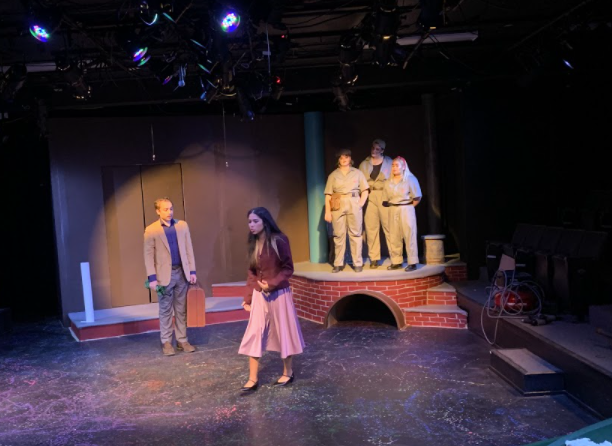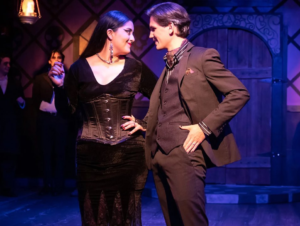The University of St. Thomas Drama department wrapped up its performance of Eurydice by playwright Sarah Ruhl on Saturday, Oct. 9 after two weekends of performances in the Jones black-box theatre.
The tale of Orpheus and Eurydice has been performed by theatre companies for thousands of years. In the traditional story, we follow Orpheus’ journey in the Underworld as he searches for his lover Eurydice, who struggles to maintain memories of the life she had before her death.
The play performed by the drama department, however, follows Eurydice rather than Orpheus as she traverses through the Underworld.
In this retelling, sophomore drama major Mia Terry starred in the titular role of Eurydice, junior international business major Hunter Filipovitch played Orpheus, senior BA/MA in philosophy Nicolas D’amelio was the father, freshman chemistry major James Kong was the Lord of the Underworld. Senior biology major Duyen Nguyen, senior drama major Ann Ridley, and junior drama major Olivia Knuckols played the Stones.
The show opens with a romantic scene between Filipovitch’s Orpheus and Terry’s Eurydice at a beach, with Orpheus presenting the scenery as a gift to Eurydice. Although it is an endearing lovers’ display, we can detect some unaddressed tension between them. The scene ends with a wedding proposal from Orpheus, which Eurydice accepts. In the next scene, Eurydice’s late father, who goes unnamed for the entirety of the play, is seen writing a letter from the Underworld to his daughter for her wedding day, advising her as he would if able to give a speech at the reception. It is a beautifully tragic moment when both the father and the audience realize that there is no way for the letter to reach Eurydice.
Then, a distraction from her own wedding party leads Eurydice to her tragic demise. While taking a break from her wedding reception, an “Interesting Man” (Kong’s Lord of the Underworld) tells Eurydice that he has a letter addressed to her from her father. The man leads her to his high-rise apartment, where he makes unwanted advances. In her attempt to flee, she tumbles down the apartment stairs and dies. For the rest of the play, we see Eurydice’s interacting with the dead and undead of the Underworld, primarily her father.
There were many key performances animating the play. One actor who shined was Kong, playing Hades, the Lord of the Underworld. Hades is a dynamic character who switches tone at the drop of a hat, and Kong executed this perfectly. There are scenes where the audience was meant to be made uncomfortable by the Lord of the Underworld’s salacious advances on Eurydice, while in other scenes he behaves child-like, a type of “aging backward.” Kong’s ability to shift his emotions and tone had the audience abuzz with praise after the show.
Another actor with a breathtaking performance was D’Amelio as the father, who seems to have a keen understanding of how to arouse the audience’s emotions. Key moments in the play, such as the scene with the letter, allowed D’amelio his character’s love for Eurydice to shine.
The set and lighting choices played important roles in telling the story as well. According to junior Jackie Kong, stage manager and assistant director, the set was meant to resemble a dank basement. While unremarkable at first glance, the set featured a set of stairs and a pipe running underneath on the north side of the stage, and a well on the south side. The surprising element of the set was the implementation of an elevator, which had water falling inside to express the prevalence of water within the play. To further display the importance of water, the stage lighting gave many scenes a blue hue, and water could be heard running and dripping throughout the show.
Creative use of the theatre’s limited space was a major factor of the performance. One unique element of the set design was the use of the pipe. In one scene, we see Hades, lying on his back, shoot out of the pipe on a skateboard.
While the costume styling initially felt haphazard, the audience soon saw that the different styles represented different eras, both ancient and modern, depending on when each character in the underworld had died.
The play overall was funny and charming, mixed with some uneasy moments of introspection. UST’s Eurydice forced us to examine the way we view those we love and serves as a warning about what we perceive love to truly be. According to Kong, the play highlights the importance of being able to appreciate what one has experienced in life through Eurydice’s own struggle to look back on her life experiences.
“I think it’s about the true meaning of love and how death impacts that,” Kong said.









Be First to Comment